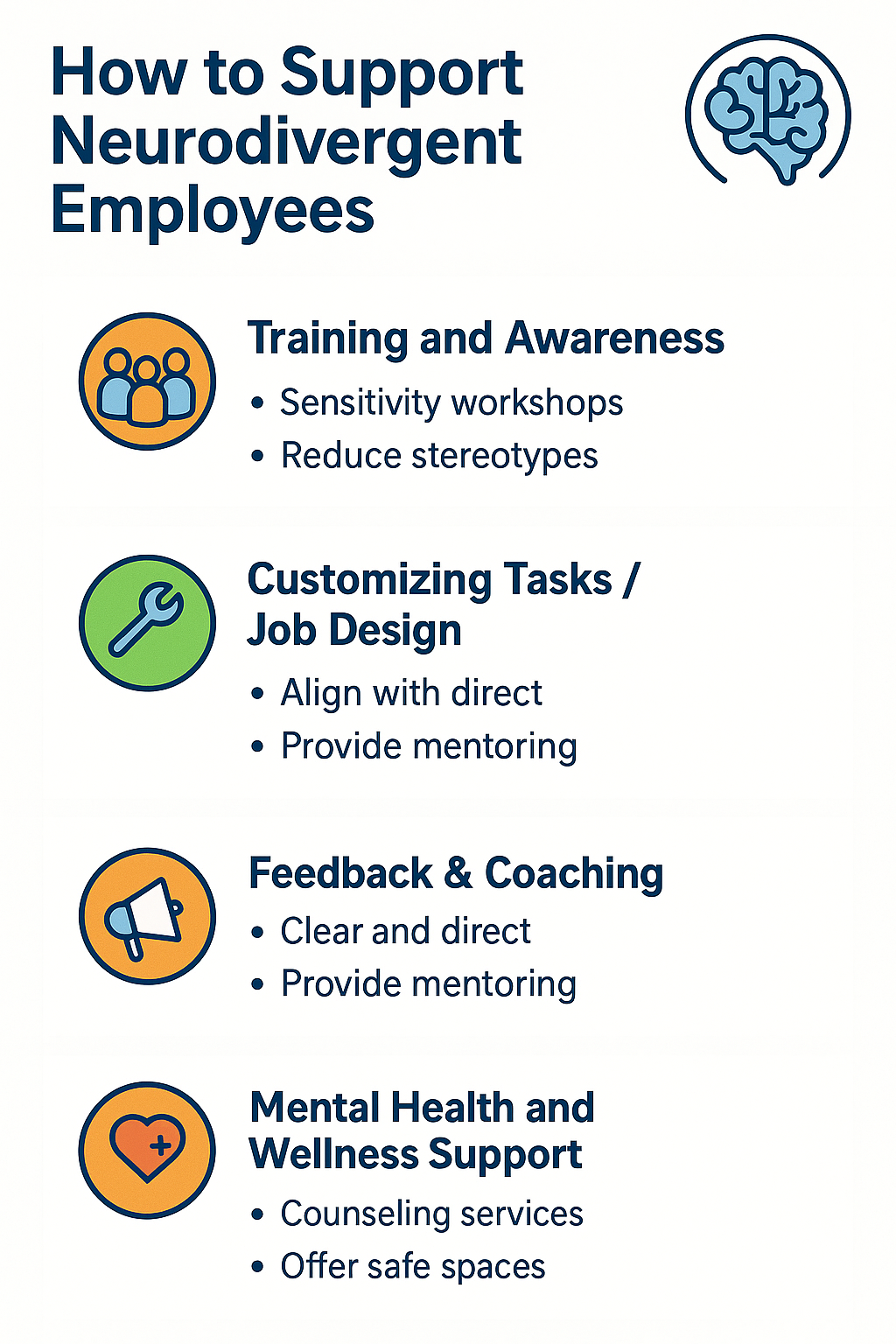Many neurodivergent employees still feel unseen or unsupported at work. They may face barriers in communication, workplace design, or bias from colleagues. These challenges prevent them from reaching their full potential and can limit the growth of organizations as well.
To understand this issue, it is important to know what neurodiversity is in the workplace. Neurodiversity refers to the natural differences in how people think, process, and learn. It includes a wide range of conditions such as autism, ADHD, dyslexia, and others. Recognizing neurodiversity in the workplace means accepting that people approach problems, tasks, and communication in unique ways.
In this blog, we will explore what neurodivergence in the workplace looks like, why it matters, strengths and challenges faced by neurodivergent employees, practical strategies for managing neurodivergent employees, and best practices for inclusion. We will also address common barriers and share how organizations can provide better support.
Understanding Neurodivergence in the Workplace
Neurodivergence in the workplace is an important topic for modern organizations. It is not about labeling employees but about appreciating the different ways in which they think and contribute. A workplace that understands this can create opportunities for employees to succeed.
What Does “Neurodivergent” Mean
Neurodivergent employees are individuals whose brains function differently from what is considered typical. This includes people with autism, ADHD, dyslexia, dyspraxia, Tourette’s, and other conditions. These employees may learn, communicate, or solve problems in ways that are different but equally valuable. It is important to remember that neurodivergent does not mean less capable. It means different.
Common Neurodivergent Strengths and Traits
Many neurodivergent employees bring unique strengths to their roles. Some excel in creativity and problem-solving. Others show strong attention to detail, persistence, and innovative thinking. For example, employees with autism often demonstrate exceptional pattern recognition and memory skills. Those with ADHD may bring high energy and new ideas to projects. These traits can be powerful assets to organizations that know how to harness them.
Common Challenges Faced by Neurodivergent Employees
At the same time, neurodivergent employees can face challenges at work. Communication barriers are common, especially in environments that rely on social cues. Sensory overload in traditional offices, such as bright lighting or loud sounds, can also be difficult. Vague instructions may create confusion, while bias from colleagues or managers may limit opportunities for growth. Recognizing these challenges is the first step toward building better support systems.

Why Neurodiversity in the Workplace Matters
Neurodiversity in the workplace is important for both people and organizations. An inclusive environment supports employee wellbeing while also driving better business outcomes. Leaders who understand this can build stronger, more effective teams.
Innovation and Problem Solving
Neurodivergent employees often approach problems differently from their peers. This diverse thinking brings unique solutions that help businesses outperform competitors. Companies that welcome these perspectives are more innovative and adaptable.
Improved Retention and Employee Satisfaction
The importance of inclusion in the workplace becomes clear when we look at retention rates. Employees who feel valued and supported are more likely to stay. Neurodivergent employees are no different. When organizations create inclusive environments, satisfaction and loyalty increase.
Broader Talent Pool and Diversity of Thought
Bias often prevents skilled neurodivergent employees from being hired. By addressing this, companies gain access to a wider talent pool. Diversity of thought brings new approaches to old problems and makes teams stronger.
Better Mental Health and Team Belonging
Supportive workplaces improve mental health for all employees. Neurodivergent workers experience less stress when they feel accepted. Teams also benefit from stronger trust and belonging. This shows why inclusion is important in the workplace beyond business performance.
Working with Neurodivergent Colleagues & Managing Neurodivergent Employees
Managing neurodivergent employees requires awareness and empathy. Colleagues also play a role in creating environments where everyone can succeed. Simple adjustments in communication, expectations, and support can make a big difference.
Establish Clear Routines and Expectations
Clear routines help reduce confusion. Written instructions, checklists, and specific deadlines give neurodivergent employees clarity. Managers should avoid vague directions and instead provide step-by-step expectations.
Adapt Communication Styles
Communication should be flexible. Some employees prefer written instructions while others do better with visuals or verbal explanations. Managers should check for understanding without judgment. This helps build trust and avoids unnecessary stress.
Provide Accommodations and Flexible Environments
Accommodations are not special treatment. They are tools that allow employees to perform at their best. Examples include noise-reducing headphones, flexible working hours, and remote work options. Adjusting workspaces to meet individual needs shows real commitment to inclusion.
Sensory-Friendly Spaces
Many neurodivergent employees experience sensory sensitivity. Providing quiet rooms, flexible lighting, and reduced distractions can help. These adjustments reduce stress and improve focus for everyone, not just neurodivergent employees.
How to Support Neurodivergent Employees
Organizations that want to build inclusive environments must go beyond words. They need concrete strategies to support neurodivergent employees in daily work.
Training and Awareness for All Staff
Awareness is key. Sensitization workshops help staff understand neurodiversity. Training reduces stereotypes and creates empathy across teams. When everyone learns how to work together, inclusion becomes part of the culture.
Customizing Tasks / Job Design
Not all roles need to be done in the same way. Customizing tasks to align with individual strengths improves performance. For example, employees who excel in detail-oriented tasks may prefer analytical work. Offering flexibility in how work is completed allows employees to thrive.
Feedback & Coaching
Constructive feedback helps employees grow. For neurodivergent employees, feedback should be clear and direct. Coaching and mentoring programs also provide ongoing guidance. This builds confidence and supports career development.
Mental Health and Wellness Support
Supporting neurodivergent employees also means caring for their mental health. Organizations can offer counseling, employee assistance programs, and regular check-ins. Creating safe spaces for open conversations shows that the company values wellbeing.

Challenges & Barriers to Inclusion
Even with the best intentions, organizations face barriers when building inclusivity for neurodivergent employees. Recognizing these challenges helps leaders address them more effectively.
Unconscious Bias and Misconceptions
Bias is one of the biggest barriers. Many people still hold stereotypes about neurodivergent employees. Some managers believe they cannot perform certain roles. These misconceptions limit opportunities and prevent organizations from accessing valuable talent.
Rigid Work Processes
Traditional work processes can create unnecessary barriers. Strict office rules, fixed schedules, and inflexible systems do not work for everyone. Neurodivergent employees often thrive when given flexibility, but many workplaces resist change.
Disclosure and Privacy Concerns
Disclosure is another sensitive issue. Many neurodivergent employees fear stigma or discrimination if they share their condition. Without clear policies and support, they may choose to remain silent, which prevents them from receiving accommodations.
Best Practices / Strategies for Inclusion
Building neuroinclusive workplaces requires both strategy and empathy. The following best practices can help organizations create long-term change.
Inclusive Hiring Practices
Hiring processes should be inclusive from the start. Skills-based assessments allow candidates to show their abilities without being judged by social performance alone. Job descriptions should be clear and accessible. This ensures that talented neurodivergent candidates are not overlooked.
Flexible Work Arrangements
Flexibility benefits all employees but is especially important for neurodivergent staff. Remote work options, adjusted schedules, and flexible environments allow people to work in ways that suit them best. Productivity increases when employees are comfortable.
Providing Clear & Multiple Channels for Communication
Communication is not one-size-fits-all. Offering written, verbal, and visual instructions ensures that everyone can process information effectively. Feedback loops should also be encouraged so employees feel heard.
Celebrating Neurodivergent Strengths and Creating Belonging
Recognition matters. Highlighting the contributions of neurodivergent employees shows that their strengths are valued. Role models should be celebrated, and achievements should be recognized publicly. This builds belonging and strengthens workplace culture.

Let Yuna Help with Neurodiversity & Inclusion
Supporting neurodiversity in the workplace is not just a goal but a responsibility. Yuna Health provides tools, reminders, and training programs that help organizations make inclusion real. From inclusive communication aids to wellness tracking, Yuna helps leaders create workplaces where neurodivergent employees can succeed.
Yuna also supports managers in building belonging. Leaders can track progress, encourage feedback, and make data-driven improvements. Employees benefit from structured routines, mindful reminders, and accessible resources that reduce stress and improve performance.
Partnering with Yuna helps organizations understand how to support neurodivergent employees while creating stronger, more inclusive teams. By making inclusion a daily practice, businesses can unlock potential and build a healthier future for all.


.webp)



